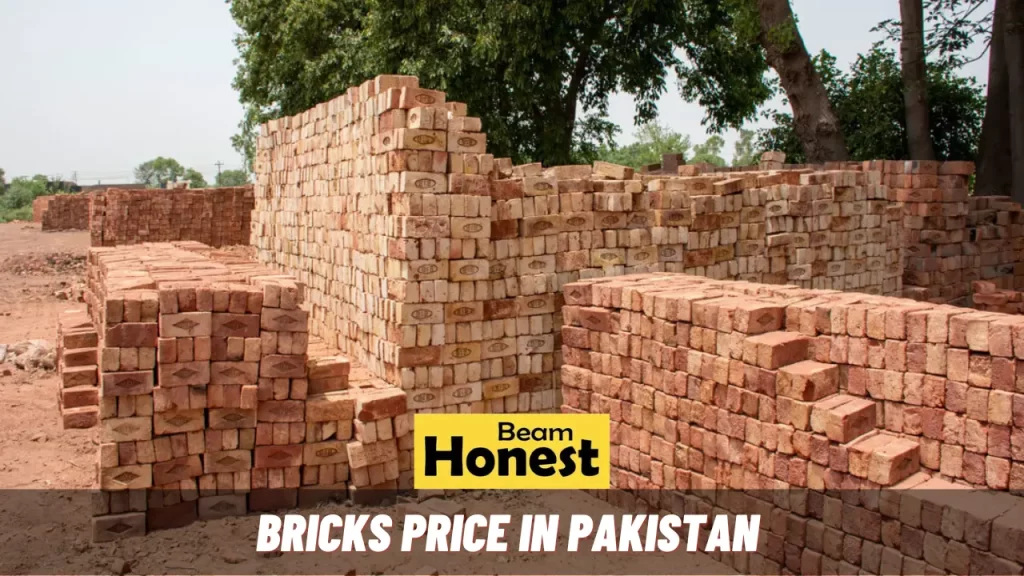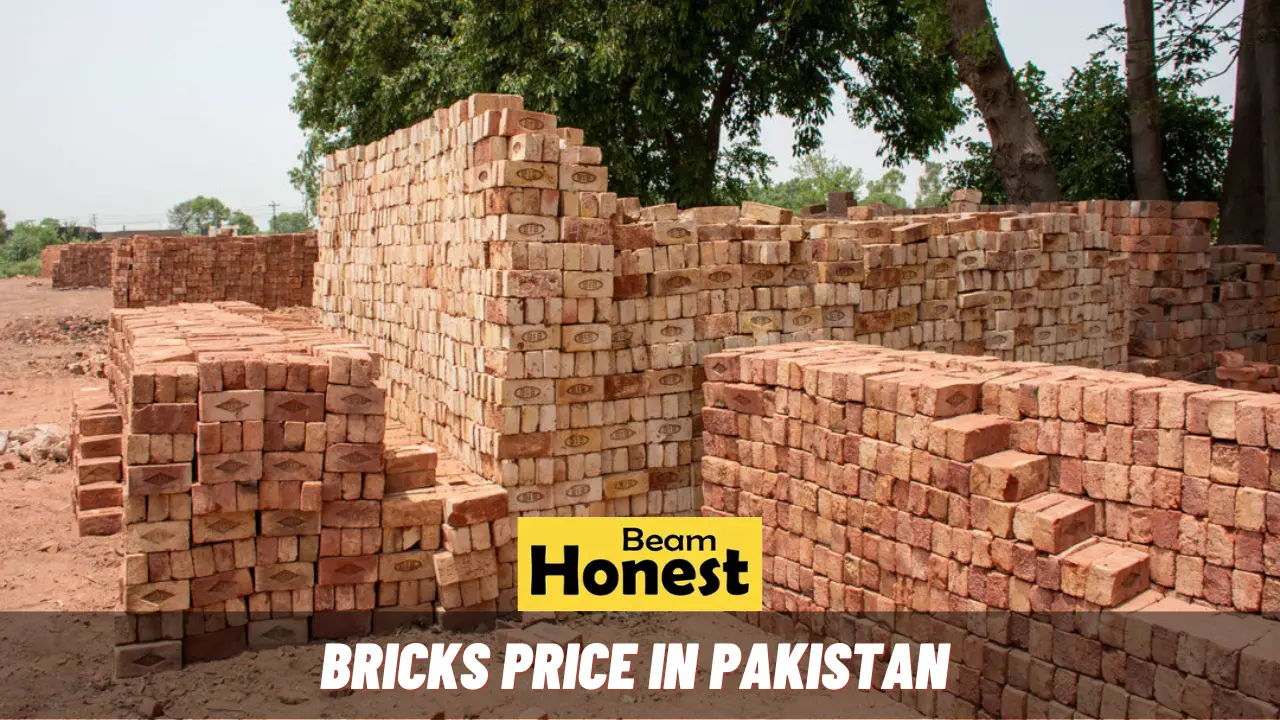Bricks are at the core of construction projects, serving as an essential building material. Within Pakistan’s constantly shifting construction landscape, the bricks price has become an integral factor in shaping and executing construction ventures. As demand for urban infrastructure and housing projects surges, understanding how brick prices work becomes critical to successful project planning and execution. In this piece, we will explore the current price ranges of bricks in Pakistan and also explore various types of bricks available in the market.

Bricks Price in Pakistan Today 2025
As we explore Pakistani brick pricing this year, illuminating insights are revealed about their pricing landscape. While single brick costs range between Rs. 9 to 16, with variations depending upon factors like brick type, quality, and regional dynamics; when purchasing 1000 or 3000 bricks at once however, their price per thousand ranges more freely between Rs. 9,000 to 16,000 or Rs. 27,000 to 48,000 respectively allowing project managers greater adaptability when creating budgeting and procurement strategies to match construction projects of their scope.
| Brand | 1 Brick Price | 1000 Bricks Price | 3000 Bricks Price |
|---|---|---|---|
| Khingar brick | Rs. 9 | Rs. 9,000 | Rs. 27,000 |
| B-grade brick (ii-brick) | Rs. 11 | Rs. 11,000 | Rs. 33,000 |
| Fly Ash brick | Rs. 16 | Rs. 16,000 | Rs. 48,000 |
| A class brick 101 | Rs. 14 | Rs. 14,000 | Rs. 42,000 |
| Awwal brick (machine-made) | Rs. 13 | Rs. 13,000 | Rs. 39,000 |
| C-grade brick | Rs. 10 | Rs. 10,000 | Rs. 30,000 |
| Awwal tile bricks (A-grade) | Rs. 14 | Rs. 14,000 | Rs. 42,000 |
Red Brick Size in Pakistan
Within the realm of construction materials, red bricks stand out. These basic building blocks come in various dimensions in Pakistan. A standard size referred to as the “nominal size” of red brick is 9 inches by 4.5 inches by 3 inches; this uniformity ensures sturdy walls that will stand the test of time and environmental pressures.
Pakistan’s construction market offers an array of brick types to meet individual project requirements, ranging from solid to hollow bricks. Solid bricks provide robustness and durability; hollow ones, on the other hand, boast insulation properties for more energy-efficient designs.
| Length | Width | Height |
|---|---|---|
| 9 inches | 4 inches | 3 inches |
Also Read:
Calculating Brick Quantity Calculation
Accurate brick quantity calculation is an integral component of any successful construction project. Determining the necessary number of bricks requires taking a systematic approach that takes into account dimensions, mortar thickness, and the layout of the construction site – this ensures no material waste and smooth progress of construction activities.
Types of Bricks Available in Pakistan
Pakistan boasts an expansive selection of brick types tailored specifically to specific construction needs and preferences, giving architects and builders plenty of choices to tailor their selections to project requirements. Below are some prominent types of bricks currently found here in Pakistan:
Burnt Clay Bricks
Burnt clay bricks are essential building blocks, formed through the baking of molded clay in kilns. These durable and strong bricks exhibit exceptional durability and strength ideal for load-bearing structures.
Fly Ash Clay Bricks
Fly ash clay bricks are an eco-friendly product of sustainable engineering that incorporates fly ash derived from coal combustion into their composition, not only recycling industrial waste but also increasing the thermal insulation properties of bricks.
Engineering Bricks
Engineered to possess unique qualities, engineering bricks are manufactured specifically to fit specific applications. Their characteristics include high compressive strength, low water absorption, and resistance to frost and chemicals.
Concrete bricks
Concrete bricks, as the name implies, are formed using a mixture of cement, aggregates, and water. As with concrete structures, these bricks inherit their durability and strength for use in many different applications. However, their versatility also allows builders to meet various architectural aesthetic requirements with varied finishes, colors, sizes, and shapes that will give each project its own distinct character.
Sand Lime Bricks
Sand lime bricks combine the strength of lime with the fine texture of sand to form an innovative building material. These bricks undergo autoclaving – an industrial chemical process in which high pressure and steam are used – in order to preserve their qualities for use as construction material.
Factors Affecting Bricks Price in Pakistan
Pakistan’s complex brick pricing model is composed of multiple factors that collectively dictate its cost dynamics, including economic, industrial, and market forces that influence brick prices. Understanding these influences is essential for effective decision-making and budget management by stakeholders navigating Pakistan’s construction landscape.
Raw Material Costs
At the core of brick production lies clay, the primary raw material. Fluctuations in the availability and quality of this raw material can have significant ramifications on cost. Geological factors, extraction methods, and transportation expenses all play a part in contributing to total expenditure relating to raw materials; ultimately forming the basis for pricing decisions.
Manufacturing Techniques
The method employed when producing bricks has an immense effect on their final cost. Traditional processes utilizing manual labor may yield unique products but are time and labor-intensive; mechanized techniques, however, streamline production while potentially lowering costs.
Energy Costs
Brick production’s firing process demands substantial energy input. Kilns used for firing require fuel sources, with fluctuating energy costs having an immediate impact on overall expenditures and brick prices.
Market Demand and Supply
Demand and supply have an indelible effect on brick prices. When construction activity increases rapidly, increased demand can outstrip supply, leading to potential price escalation. However, conversely, oversupply may cause prices to experience downward pressure.
Transportation and Logisticalitat
Moving brick production centers to construction sites requires transportation and logistics operations which have a substantial effect on final costs. Distance, infrastructure quality, and fuel prices all play a role. Efficient logistical operations can help mitigate some costs associated with this journey and produce more competitive pricing structures.
Understanding the Brick Manufacturing Process
Gaining an appreciation of how bricks are produced sheds light on its complex manufacturing process. The production stage encompasses several steps and steps before reaching completion:
Preparing Clay
- Unsoiling: The initial step involves unplugging impurities such as rocks and debris from the clay to produce an even base material.
- Digging: Clay should then be extracted from quarries or soil deposits in order to prepare it for further processing.
- Cleaning: Once extracted clay has been washed to remove finer particles, its quality is further improved through washing. For weathering purposes, clay exposed to natural elements helps increase plasticity for easier molding processes.
Moulding:
When ready, this clay must then undergo molding in an environment suitable for this activity. Prepared clay is formed into bricks using molds with precision and consistency for structural integrity.
Drying:
Once molded bricks have been assembled, they must be air-dried to reduce moisture content and avoid deformities during firing.
Burning:
Bricks are heated at high temperatures in a kiln to bring about chemical changes and increase strength and durability.
Also Read:
Conclusion Of Bricks Price
As Pakistan’s construction sphere propels forward, the intricate dynamics of brick pricing occupy a pivotal role. The price range of bricks, influenced by factors like type, quantity, and market forces, offers both flexibility and challenges to project managers. Understanding the nuances of brick manufacturing and its underlying processes further enriches our comprehension of the construction industry’s backbone. In this pursuit, stakeholders are armed with insights to make informed decisions that bridge quality and cost-effectiveness.
Frequently Asked Questions (FAQs)
Bricks Price in Pakistan is influenced by various factors, including raw material costs, manufacturing techniques, transportation expenses, and market demand.
The Pakistani construction market offers various brick types, including solid bricks and hollow bricks, each designed to cater to specific construction needs.
The standard size of a red brick in Pakistan is 9 inches by 4.5 inches by 3 inches.
The brick manufacturing process in Pakistan involves stages like clay preparation, molding, drying, and firing in kilns to produce the final product.
Accurate brick quantity calculation is crucial in preventing material wastage and ensuring the smooth progress of construction activities, ultimately optimizing costs and resources.

